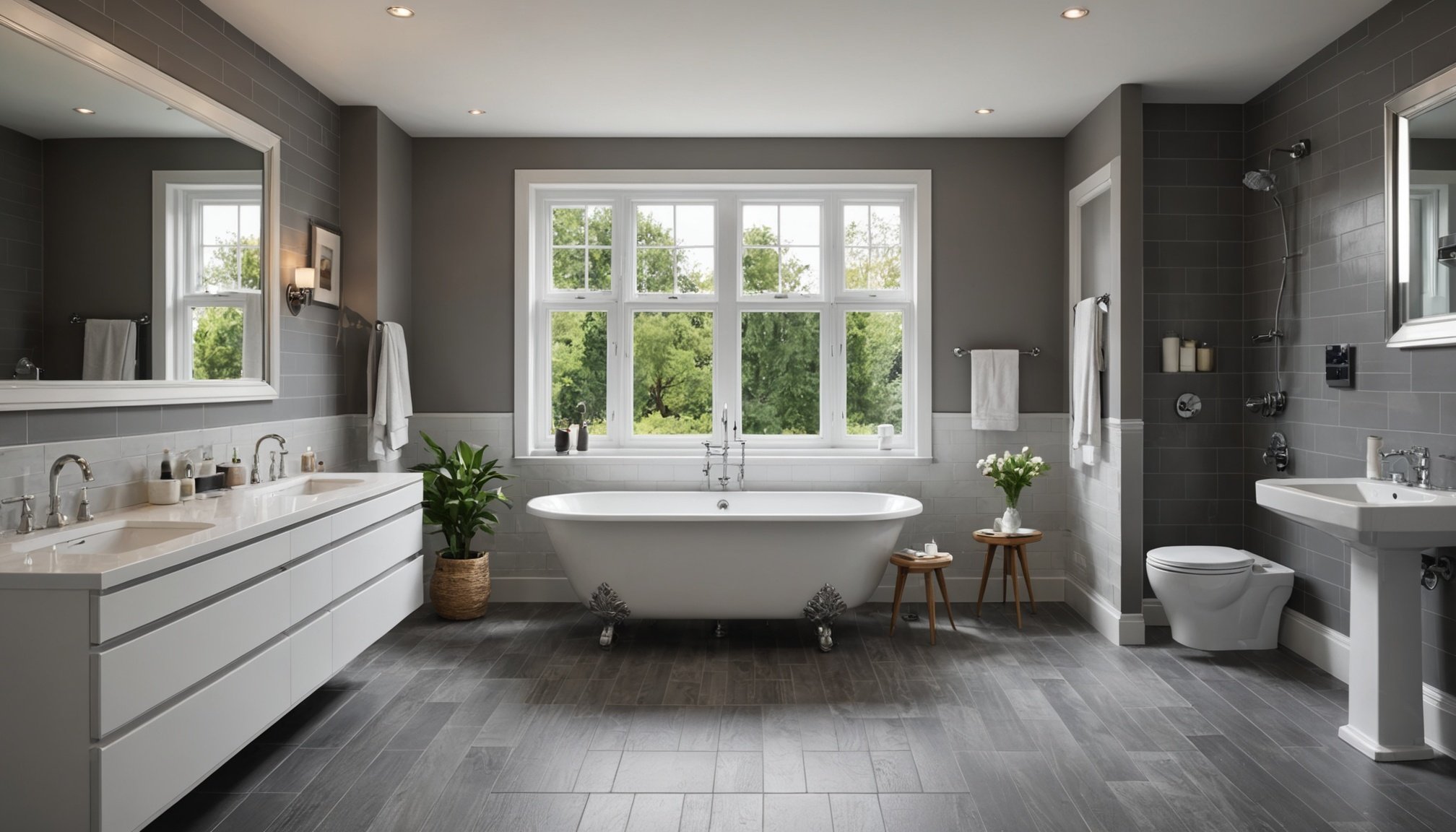Understanding Heated Floor Systems
Heated floor systems have become a popular choice in bathroom renovation projects, offering both comfort and style. These systems work by circulating warm air or water beneath the flooring surface, providing consistent and efficient warmth throughout the room. This means that every step feels luxurious, even on the coldest mornings.
Types of Heated Floors
There are two primary types of underfloor heating systems suitable for bathrooms: electric and hydronic. Electric floor heating systems use cables installed beneath the bathroom tiles, offering an easier and often cheaper installation process. They are ideal for smaller spaces or as a retrofit solution during a heated floor installation. Hydronic systems, on the other hand, use hot water circulated through pipes. These are more energy-efficient than electric systems, making them a favourable choice for larger bathroom spaces.
Dans le meme genre : Discover the Advantages of Utilizing a Convection Heater in Your UK Conservatory
Energy Efficiency and Comfort
When considering a heated floor installation, energy efficiency is a crucial factor. Electric systems can be more expensive to operate, so it’s important to consider the bathroom’s size and usage frequency. Conversely, hydronic systems, while initially more costly to install, provide long-term savings and enhanced comfort, especially in larger bathrooms. Integrating energy-efficient heated floors into a bathroom renovation not only enhances comfort but also increases the overall value of a home.
Preparation for Installation
Before diving into the exciting world of heated floors, it’s crucial to conduct a thorough site assessment. Start by measuring your bathroom to ensure the proposed heating system will fit seamlessly. Consider the layout, including permanent fixtures like the toilet and sink, which should remain unrestricted by the heating elements.
Sujet a lire : Top Strategies to Reduce Noise Between Shared Walls in UK Apartments: A Comprehensive Guide
In your bathroom renovation preparation, gather essential tools and materials. You’ll need underfloor heating mats or cables, a thermostat, a suitable floor covering, and electric safety gear. Don’t forget hand tools like a cutter and adhesive tapes. Having these on hand ensures a smooth installation process without unnecessary interruptions.
Prior to installation, evaluate your current heating system and electrical setup. Determine if your electrical circuit can handle the additional load of heated floors. Consulting with an electrician could be wise here, especially if upgrades are necessary. This step helps avoid any potential electrical issues post-installation.
By taking the time to prepare meticulously, your heated floor project is likely to be successful, adding a touch of luxury and comfort to your bathroom. Remember, thorough planning leads to a smoother installation and warmer, more inviting bathroom space.
Step-by-Step Installation Guide
When embarking on the journey of heated floor installation, having a clear plan is vital. This guide will provide practical installation steps and DIY tips to ensure success.
Pre-Installation Checklist
Before you begin, ensure all tools and materials are ready. A successful installation starts with a well-prepared subfloor. Check for dryness and cleanliness, as moisture can hinder adhesive effectiveness. Confirm you have sufficient heating mat to cover the area intended.
Laying the Heating Mat
Positioning the heating mat accurately is crucial. Begin at the furthest point from the power source and methodically unroll it across the subfloor. Ensure that mats are aligned, avoiding overlaps. Secure them with approved adhesives or tapes, ensuring a flat and stable surface.
Connecting to Power Supply
Adhering strictly to safety protocols during electrical work is non-negotiable. Ensure the power supply is switched off before connecting the mat. Follow your system’s user manual closely, using only compatible components for connections. Ground fault circuit interrupters (GFCIs) are highly recommended for added safety.
Safety and preparation markedly impact the success of a heated floor project. By following these instructions, you not only achieve efficient installation but also ensure longevity and optimal performance of your warm floors.
Common Pitfalls and How to Avoid Them
When dealing with heated floor installations, avoiding common pitfalls is crucial for long-term success. One frequent mistake is incorrect floor preparation, such as failing to level the subfloor. This can lead to uneven heating and potential damage to the heating elements. To prevent this, ensure the subfloor is clean, dry, and level before installation.
Another common error involves improper wiring connections. Incorrectly wired systems may not only malfunction but can also pose safety hazards. Always follow the manufacturer’s instructions carefully and consider hiring a qualified electrician for complex setups.
Installation Mistakes
Mistakes also occur when choosing unsuitable materials. It’s essential to use materials compatible with heated floors, as some could restrict heat flow or be damaged by high temperatures. Make informed decisions by consulting product specifications and expert advice.
Troubleshooting Heated Floor Issues
Post-installation, some homeowners encounter troubleshooting issues, such as cold spots or uneven heating. These problems might stem from installation errors or defective components. Identifying the cause early is vital to implementing the correct solution, which could range from adjusting misaligned cables to replacing faulty parts.
By understanding these pitfalls and how to avoid them, you’ll ensure efficient and reliable heated flooring in your space.
Cost Considerations and Budgeting
When planning for heated floor installation, understanding the varied costs is crucial. The expenses can range widely, impacted by the choice of materials, the size of the area, and the specific system selected. For an accurate budgeting approach, it’s essential to break down these elements.
Materials and Systems
The material used is a primary factor influencing total costs. Electric systems might be less expensive upfront compared to hydronic systems, which involve complex installations and are generally suited for larger areas. However, hydronic systems can offer long-term savings due to energy efficiency. Selecting cost-effective options like prefabricated mats can significantly reduce initial expenses without sacrificing quality.
Contractor Quotes
To avoid overpaying, always obtain multiple quotes from contractors. Each quote provides insight into price variations and includes labor, materials, and additional expenses. This practice not only helps in price comparison but also ensures transparency regarding what services you’re receiving. Some contractors might provide a comprehensive package at competitive rates.
Adopting an informed and strategic approach when reviewing quotes empowers you to make informed decisions. Opt for technologies and solutions that align with your financial capabilities while providing the desired comfort and efficiency.
Compliance with UK Building Regulations
When it comes to installing heated floors, adhering to UK building regulations is not just advisable—it’s mandatory. These regulations are in place to ensure safety and efficiency. One of the most crucial standards in this context is the Building Regulations Part L, which focuses on energy efficiency. Ensuring your heated floor system complies with this is essential to achieving optimal energy use.
Key Regulations to Be Aware Of
The primary regulations include the electrical safety standards outlined in Part P, which governs the installation’s safety. For instance, all electrical work must meet the Institute of Engineering and Technology (IET) Wiring Regulations. Additionally, if the installation affects structural elements, you must consider Part A, which provides guidance on structural integrity.
Ensuring Legal Compliance
To ensure your heated floor installation meets legal requirements, collaboration with a certified installer is crucial. They should be familiar with all relevant regulations to ensure proper procedures are followed. This not only ensures safety but also protects against potential penalties or having to redo the installation.
Role of Local Authorities and Inspections
Local authorities often play a significant role in overseeing building regulations compliance. While not every project will require inspection, they can offer advice and perform inspections if necessary. Engaging with them early can help navigate the process smoothly, ensuring all safety standards are met effectively.
Product Recommendations and Expert Insights
Choosing the right heated floor products can be an overwhelming task, but certain brands consistently receive high praise from both users and industry experts. For instance, Nuheat and Warmup are recommended due to their innovative technology and reliable performance. Opting for these products ensures a blend of efficiency and durability.
Installation strategies are crucial for optimizing the functionality of heated floors. Experts advise focusing on proper insulation to enhance heat retention and energy efficiency. Additionally, utilizing high-quality installation products, like thermostats and programmable timers, can vastly improve system performance.
Warranty and customer service should not be overlooked when selecting heated floor products. Brands that offer comprehensive warranties provide added peace of mind, safeguarding against potential malfunctions. Before purchasing, investigate the warranty terms to ensure ample coverage for both components and labor.
Moreover, customer service is essential for guiding you through the initial decisions and any troubleshooting that may arise post-installation. Quick, effective support can make a notable difference in how smoothly your system operates and help curb long-term costs. Therefore, it’s beneficial to choose companies renowned for exceptional customer service, ensuring reliable assistance whenever needed.











